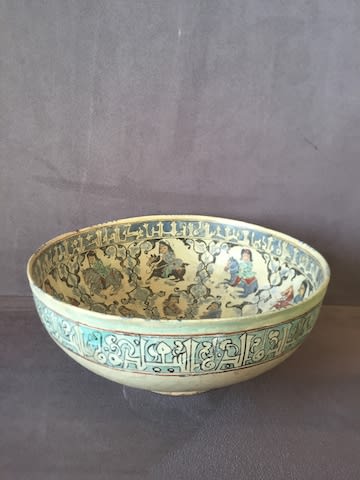Mina'i Pottery Bowl, 12th Century CE - 13th Century CE
Fritware - Composite
9.4 x 21.6 cm
3 3/4 x 8 1/2 in
3 3/4 x 8 1/2 in
AMD.173
Further images
Probably one of the most beautiful types of Iranian pottery that was produced during the Seljuk period is that of the overglaze painting. In Persian, the names of Mina i...
Probably one of the most beautiful types of Iranian pottery that was produced during the Seljuk period is that of the overglaze painting. In Persian, the names of Mina i (enamel), or Haft-rangi (seven colours) are used. It seemed logical for potters of this period to attempt the most difficult decoration, primarily painting in polychrome over the glaze. The colours used were indeed seven, as their name suggests: cobalt blue, red, green or turquoise, white, brown or black, white, gold and yellow.
Polychrome overglaze painted ceramics decorated in a range of colors in a style similar to that found on manuscript illustrations became popular during the Seljuk period in Iran. The Mina i technique involved a complicated double-firing process. The polychrome overglaze-painted pottery of the Mina'i type is seen to document the art of painting in Seljuk Iran most vividly and accurately. The potters were able to develop highly detailed narrative scenes in a way not possible before.
The major, and perhaps the only centre for Mina i production was believed to be at Kashan. These types of wares were made for a comparatively short period of time. Horsemen were favorite subjects in these works, and this is a beautiful and elaborate example. The central princely horseman is in full motion while his courtly entourage canters around the circumference of the bowl, with a row of seated courtiers beneath them. The colours have withstood the test of time very well. The outline of the illustration and arabesque decorations can be seen in black and further arabesque flourishes and colouring are in cobalt blue. The inscriptions on the inside and on the exterior of the bowl are in white relief against the blue background. It is noteworthy that in this as well as other pieces the decoration is on the inside of the bowl and there is very little decoration on the outside, which further attests to the fact that these items had a very special purpose and were certainly not used for common function. Other figures are colored in green, rust red and brown, which gives great life to the horses and excitement to the composition.
Several Mina i pieces are known and documented that render episodes from celebrated poetic texts, illustrated versions of which have rarely survived in other media before the 14th century. The general repertory of Mina i ware would seem to represent the iconography of princely life, the entertainments of the princely court, hunting, the chase, the game of polo and the exploits of war. Many items are also inscribed with poetic texts reflecting a curios melancholy. These were clearly not wares for common use and their specific meaning and function in Persian society of the 12th and 13th centuries remains to be explored in full. This is a very festive and joyful piece, which would be the envy of any collector.
Polychrome overglaze painted ceramics decorated in a range of colors in a style similar to that found on manuscript illustrations became popular during the Seljuk period in Iran. The Mina i technique involved a complicated double-firing process. The polychrome overglaze-painted pottery of the Mina'i type is seen to document the art of painting in Seljuk Iran most vividly and accurately. The potters were able to develop highly detailed narrative scenes in a way not possible before.
The major, and perhaps the only centre for Mina i production was believed to be at Kashan. These types of wares were made for a comparatively short period of time. Horsemen were favorite subjects in these works, and this is a beautiful and elaborate example. The central princely horseman is in full motion while his courtly entourage canters around the circumference of the bowl, with a row of seated courtiers beneath them. The colours have withstood the test of time very well. The outline of the illustration and arabesque decorations can be seen in black and further arabesque flourishes and colouring are in cobalt blue. The inscriptions on the inside and on the exterior of the bowl are in white relief against the blue background. It is noteworthy that in this as well as other pieces the decoration is on the inside of the bowl and there is very little decoration on the outside, which further attests to the fact that these items had a very special purpose and were certainly not used for common function. Other figures are colored in green, rust red and brown, which gives great life to the horses and excitement to the composition.
Several Mina i pieces are known and documented that render episodes from celebrated poetic texts, illustrated versions of which have rarely survived in other media before the 14th century. The general repertory of Mina i ware would seem to represent the iconography of princely life, the entertainments of the princely court, hunting, the chase, the game of polo and the exploits of war. Many items are also inscribed with poetic texts reflecting a curios melancholy. These were clearly not wares for common use and their specific meaning and function in Persian society of the 12th and 13th centuries remains to be explored in full. This is a very festive and joyful piece, which would be the envy of any collector.





